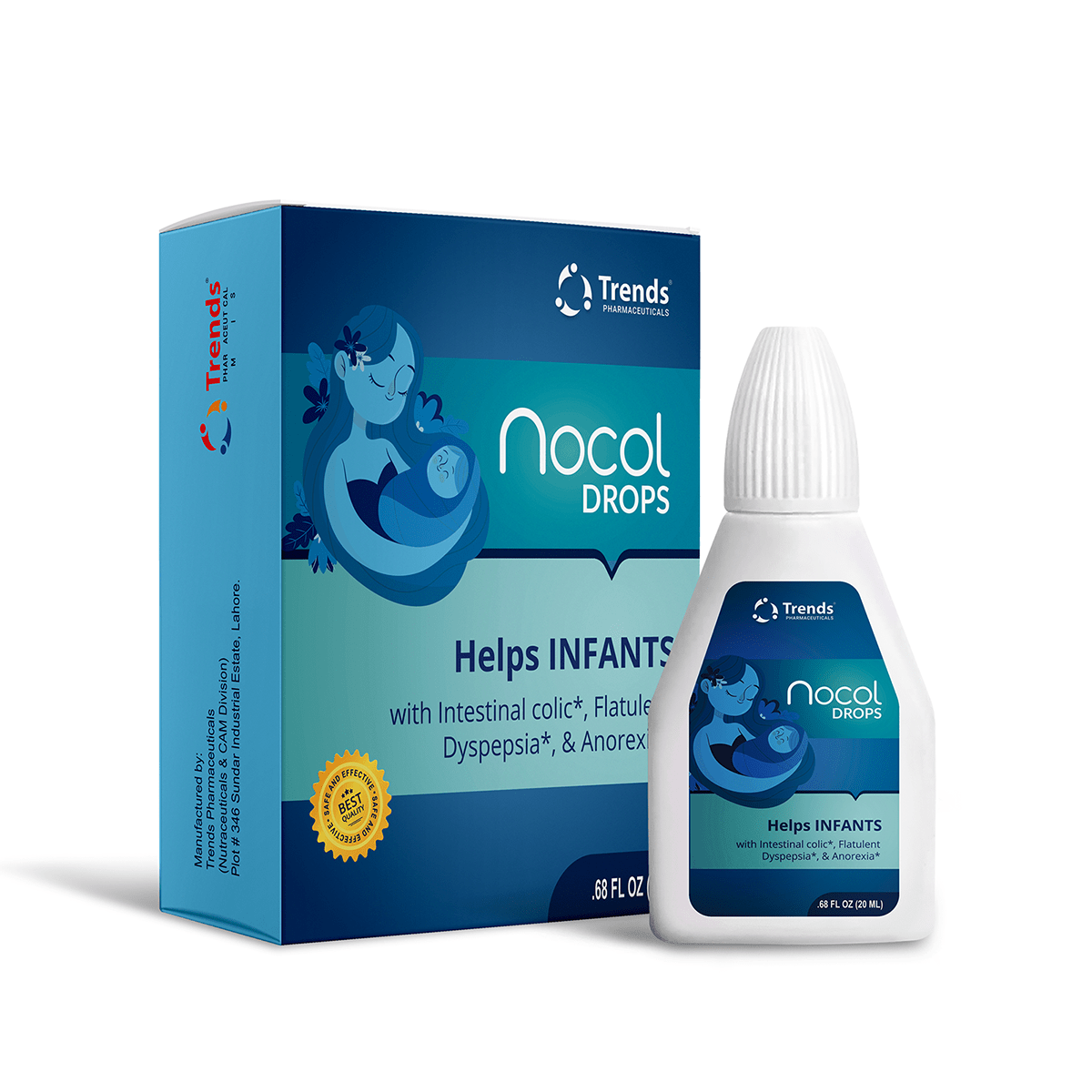Research
Note: Read the leaflet carefully before you start taking this alternative medicine and keep it safe in case you need to refer to it again for information regarding usage and dosage. If you have any further questions, consult your doctor or contact us through our website “www.trendspharmaceuticals.com”. If the symptoms worsen or persist, consult your healthcare physician.
This is a brief document and does not represent complete information regarding beneficial effects of Nocol. The information shared is primarily focused on the use of Nocol as an alternative medicine with natural carminative, laxative, anti-spasmodic, and sedative effects. The given information in any case does not limit or understate health benefits associated with daily consumption of Nocol.
NOCOL – Colic Drops
Pack Size: 10 ml
Nocol is a balanced natural herbal blend, specially designed for new-born and infants, which promotes digestive health by regulating the excretion of digestive enzymes and relaxing the gastrointestinal tract. The synergistic effect of herbal extracts in Nocol makes it clinically effective in improving intestinal colic, providing relief from distention, flatulence, and gas, which are the major causes of infant crying and pain. Nocol also helps infants
and
because it’s a natural carminative, anti-spasmodic, and sedative. Nocol is a combination of three groups of herbs. Each group is responsible for a unique set of health-benefits.
A balanced combination of carminative, anti-spasmodic, anti-emetic, and appetite stimulant medicinal herbs, divided into three groups.
Group 1:
Active substance: Zingiber Officinalis & Foeniculum Vulgare
Action: Carminative, Digestive aid, and Appetite Stimulants
Group 2:
Active substances: Mentha piperita, Hyoscyamus niger, and Caraway
Action: Antispasmodic, Pain reliever, and Relaxant
Group 3:
Active Substances: Amomum Subulatum, Cuminum cyminum, and Cassia fistula
Action: Carminative & Laxative
Suggested Use: Two (2) drops per kilo gram (kg) weight of the baby twice (2) a day or as directed by the physician
| SUPPLEMENT FACTS |
| Amount per ml | % Daily Value |
| Foeniculum Vulgare (USP) (concentrated extract of Fennel/Soonf) | 35 mg | ** |
| Cuminum cyminum (USP) (concentrated extract of Cumin/Safaid Zeera seeds, with bioactive cuminaldehyde) | 50 mg | ** |
| Amomum subulatum (USP) (concentrated extracts of Larger Cardamom/Badi Elaichi, with active cineol) | 20 mg | ** |
| Mentha Piperita (USP) (concentrated water extract of Spearmint/Pudina, with bioactive menthol) | 35 mg | ** |
| Hyoscyamus Niger (USP) (Leaf and root extracts of Henbane/Khurasani Ajwain) | 20 mg | ** |
| Cassia Fistula (USP) (Extracts from dried inner bark or leaf/flower of Golden Shower Tree) | 10 mg | ** |
| Zingiber Officinale (USP) (Concentrated water extract of Ginger Root/Adrak) | 35 mg | ** |
| Carum Carvi (USP) (Concentrated extract of Caraway seeds/Kala Zeera) | 5 mg | ** |
** Daily Value not established
Cuminum cyminum (Cumin)
MAIN ACTION: ASSISTS IN DIGESTION, CARMINATIVE, and GASTROPROTECTIVE
- Composition (Bio-actives): Cuminaldehye (45-50%), b-pinene, p-cymene, g-terpinene. (9)
Benefits: (9)
- Antioxidant-Cuminaldehyde and p-cymene protect liver against oxidative stress
- Carminative-Settles the upset stomach and eliminates gas
- Eupeptic
- Aromatic
- Pharmacokinetics:
- Bioavailability: Phytochemical analysis showed that Cuminum cyminum containes compounds: alkaloid, anthraquinone, coumarin, flavonoid, glycoside, protein, resin, saponin, tannin and steroid.
The major compounds in cumin essential oil are cuminaldehyde , tetradecane, Y-terpenene, B-ocimene, myrcene, has been found to stimulate the bioavailability of variety of nutrients .
Healthy volunteers who ingested 2 g pure curcumin powder after fasting showed less than 10 ng/mL curcumin in their plasma 1 h postdose.17 In the same study, co-ingestion of curcumin with 20 mg of piperine (black pepper) appeared to increase the bioavailability of curcumin by 2000% (11)
- Metabolism Oral cuminaldehydeis oxidized in rabbits to hydroxyl and carboxyl derivatives of p-isopropylbenzoic acid (cumic acid). Some reduction to p-cumyl alcohol also occurs (10)
- Clinical Research:
Cumin helps in digestion. It is one of the best herbs for digestive sluggishness and helps in the cure of digestive problems. It is due to cuminaldehyde that our salivary glands stimulate and this enables primary digestion of food. Thymol is another compound present in cumin that stimulates the glands secreting digestive acids to bring about complete digestion of food. Moreover, it relieves gas troubles, bloating and gurgling. (10)
Curcumin increases mucin secretion and may hence act as a gastroprotectant against irritants (13)
The active principles in the cumin may improve gut motility and help in digestion by augmenting gastrointestinal juice (enzyme) secretions. (14)
- Safety profile: Studies of curcumin in animals have confirmed a lack of significant toxicity (12)
- Drug interactions if any: (9)
| Cumin | Gingko biloba , Garlic, Aspirin, Warfarin, Clopidogrel, Ibuprofen, Naproxen | Increase the risk of bleeding |
| Antibiotics, Anticancer drugs , Antifungals, Anti-inflammatory agents, antiseizure agents, Cholesterol/lipid lowering , estrogens, GI agents | Affect the immune system |
| Glimepiride, Insulin, Pioglitazone, Glipizide, Tolbutamide | Decrease the blood sugar level |
| Antituberculosis drugs | Enhanced Rifampin levels |
Mentha Piperita (Mint)
MAIN ACTION: ANTISPASMODIC FOR INFANTILE COLIC
- Composition (Bio-actives): Menthone, menthol, menthyl acetate, carvone, piperitone, 1,8-cineole, and pulegone. (15)
- Clinical Research: Mentha piperita has a long history of safe use both in medicinal preparations and as a flavoring agent in foods. In folk medicine, it has been used as an antiemetic, antiparasitic, anti-inflammatory, antibacterial, and antispasmodic including treatment for infantile colic. Mentha piperita has a spasmolytic effect on the smooth muscle of the gastrointestinal tract. (17)
- Safety profile: The use of peppermint preparations in open skin areas of small children, especially on the nose, face and chest, is not recommended. (16)
- Drug interactions if any Potential interactions with cisapride (18)
Zingiber Officinalis (Ginger)
MAIN ACTION: ANTIEMETIC, ANTI-INFLAMMATORY, and AROMATIC
- Composition (Bio-actives):
The major constituents in ginger rhizomes are carbohydrates (50–70%), lipids (3–8%), terpenes, and phenolic compounds.Terpene components of ginger include zingiberene, β-bisabolene, α-farnesene, β-sesquiphellandrene, and α-curcumene, while phenolic compounds include gingerol, paradols, and shogaol .These gingerols (23–25%) and shogaol (18–25%) are found in higher quantity than others. (20)
The aromatic constituents include zingiberene and bisabolene, while the pungent constituents are known as gingerols and shogaols (20)
- Pharmacokinetics:
There is a limited but growing information on the pharmacokinetics and metabolism of ginger and its components. A number of studies revealed that the major components of ginger are excreted as metabolites. After oral administration of a single dose of ginger oleoresin (300 mg/kg) to rats, 8-gingerol, 10-gingerol, and 6-shogaol were detected in the plasma as the free forms, while the major pungent principle 6-gingerol mainly existed as glucuronide with a Cmax of 3.86 μg/mL and as the free form at 0.93 μg/mL about 1.2 hours after dosing . (22)
In clinical experiments, when human volunteers took 100 mg to 2 g of ginger extract, there were no free forms of gingerols and shogoal detected in plasma, but these were found as the glucuronide and sulphate conjugates. It can thus be concluded that gingerols and shogoals are rapidly absorbed in animals and humans and accumulate in a number of tissues and are extensively metabolised in the body. (22)
- Pharmacodynamics:
Ginger has recently been studied scientifically for its effect on nausea and vomiting associated with motion sickness, surgery, pregnancy and cancer chemotherapy. There may be several mechanisms of action in play related to the antiemetic properties of ginger. It has been reported that antiemetic qualities may be derived from ginger’s anti-serotoin effects o gastrointestinal and central nervous system. Antiserotonin activity prevents serotonin from binding to 5-hydroxytryptamine (5-HT3) serotonin receptors at the ends of the vagus nerve’s afferent branches, which send signals directly to vomiting center in the medulla oblongata. Preventing activation of ginger to anti-serotonin, disrupts one of the pathways leading to vomiting. (23)
Zingiberene is a monocyclic sesquiterpene that is the predominant constituent of the ginger oil. It contributes up to 35% of the essential oils in ginger rhizomes. Zingiberene is a compound that gives ginger its distinct flavoring and causes the fragrance of the spice.
Zingiberene possesses antioxidant activity as well as significant anti-inflammatory and antinociceptive property (23)
- Clinical Research: Ginger is used to treat various types of other GI problems like morning sickness, colic, upset stomach, gas, bloating, heartburn, flatulence, diarrhea, loss of appetite, and dyspepsia (discomfort after eating). According to Indian Ayurvedic medicinal system, ginger is recommended to enhance the digestion of food (20)
Modern scientific research has revealed that ginger possesses numerous therapeutic properties including antioxidant effects, an ability to inhibit the formation of inflammatory compounds, and direct anti-inflammatory effects. Ginger is very effective in preventing the symptoms of motion sickness, especially seasickness. Ginger reduces all symptoms associated with motion sickness including dizziness, nausea, vomiting, and cold sweating. Some active components of ginger are reported to stimulate digestion, absorption, relieve constipation and flatulence by increasing muscular activity in the digestive tract (21)
- Safety profile: The results of toxicological studies showed a broad safety range for ginger usage. (24)
- Drug interactions if any
The use of ginger with some medications should be avoided. Concurrent use with anticoagulants may increase the risk of bleeding, and therefore the use of the supplement with any medications that decrease platelet aggregation should only be done under monitoring by medical professionals. (24)
Hyoscyamus niger (Henbane)
MAIN ACTION : ANTISPASMODIC AND PAIN RELIEVER
- Composition (Bio-actives):
Atropine, hyoscyamine and scopolamine (25)
The chief constituent of Henbane leaves is the alkaloid Hyoscyamine, together with smaller quantities of Atropine and Hyoscine, also known as Scopolamine. (26)
- Clinical Research: The main action is in the relief of painful spasmodic affections of unstriped muscles that lead to colic or irritable bladder (26)
Hyoscyamus combines the action of its 2 therapeeutic alkaloids Hyoscyamine and Hyoscine. Because of the former it checks the secretions and relax spasms of involuntary muscles while through hyoscine, it lessens pain. (26)
- Safety profile: In spite of its toxicity, black henbane has a long history of human use for its medicinal and poisonous properties and even in sorcery in the Middle Ages. Black henbane is still valued by some for its medicinal values and is cultivated for drug companies worldwide. Black henbane contains two alkaloids (hyoscyamine and scopolamine) that are used as medicines under controlled conditions. (27)
Poisoning: Symptoms of ingestion include restlessness, excitation, convulsions, pupil dilation, difficulty in breathing, increased heart rate, and bloat. (27)
- Drug interactions if any
Antihistamines, anti-parkinsons, antispasmodics, antipscychotics and bronchodilators may cause anticholinergic syndrome when used alongwith (28)
Actions are potentiated when used with cholinergic drugs (29)
Ammomum Sublamatum (Black Cardamom)
MAIN ACTION: ENHANCES DIGESTION AND METABOLISM, AND RELIEVES STOMACH CRAMPS
- Composition (Bio-actives):
The composition of the essential oil of large cardamom are
1,8-cineole (65 to 80%) and limonene (10.3%) as a major
constituent (Patra et al., 1982).
The
composition of the essential oil of large cardamom are
1,8-cineole (65 to 80%) and limonene (10.3%) as a major
constituent (Patra et al., 1982).
The
composition of the essential oil of large cardamom are
1,8-cineole (65 to 80%) and limonene (10.3%) as a major
constituent (Patra et al., 1982).
The composition of the essential oil of Ammomum subulatum are 1,8-cineole (65-80%) and limonene (10%) as major constituent (30)
The oil was consisted of 20 components including the major ones 1,8 cineole (65.39%), α-terpineol (10.15%), β-pinene (7.23%), α-pinene (4.06%), linalool oxide (3.23%), and limonene (2.53%). (36)
- Clinical Research: Medicinally the seeds are credited with stimulant and astringent properties. The seeds of the plant are used in treating nausea, indigestion, abdominal pain and rectal diseases. (31)
Large cardamom has been recognized for its wide range of physiological and pharmacological properties. The essential oil present in large cardamom has a typical characteristic flavor and possesses medicinal properties like stimulant, stomachic, alexipharmic and astringent. For this reason, this species has been used for the treatment of indigestion, vomiting, biliousness, abdominal pains and rectal diseases (33)
Research shows cardamom to enhance secretion of stomach’s bile acid, further enhancing overall digestive process. Due to number of antioxidant and anti-inflammatory compounds found in cardamom’s extract, it also stimulates overall metabolism, while preventing other gastrointestinal problems such as acid reflux, heartburn, stomach cramps and diarrhea. This healing ability is believed to come from the same bioactive compounds that reduce muscular spasms, as the stomach line is largely made from smooth muscle cells. (34)
- Safety profile: Use cardamom pods in small amounts. Too much of spices in the food can cause gastrointestinal irritation and stomach ulcers (35)
- Drug interactions if any
Cardamom may increase the risk of bleeding. In theory, this risk may be further increased when cardamom is taken with other herbs or supplements that also increase the risk of bleeding. Multiple cases of bleeding have been reported with the use of Ginkgo biloba and two cases with Sawpalmetto. Numerous other agents may theoretically increase the risk of bleeding, although this has not been proven in most cases. Cardamom may interfere with the way the body processes certain herbs and supplements using the liver’s “cytochrome P450” enzyme system. As a result, the levels of these drugs may be increased in the blood in the short-term, causing increased effects or potentially serious adverse reactions, or decreased in the blood in the long-term, which can reduce the intended effects. Cardamom may have antispasmodic effects. Patients taking antispasmodic herbs and supplements or muscarinic agents should use with caution. (31)
Foeniculum Vulgare (Fennel)
MAIN ACTION: ANTI-COLIC AND DIGESTIVE AID
- Composition (Bio-actives):
Anethole, Beta-myrcene, Beta-pinene, Fenchone, Camphene, Limonene, Methyl-chavicol (38) (39)
- Clinical Research:
Anti-Colic Activity : Essential oil of fennel regulates the motility of smooth muscles of the intestine, while, at the same time, reducing intestinal gas. Alone, or combined with other plant medicinals, Foeniculum vulgare is indicated in the treatment of spastic gastrointestinal disturbances, in some forms of chronic colitis (which resist other treatments), in dyspepsias from gastrointestinal atony, in dyspepsias with the sensation of heaviness in the stomach, and so forth.The addition of fennel to preparations containing anthraquinonic components reduces the occurrence of abdominal pain often associated with this type of laxative (40)
Digestive Aid : Phytoconstituents such as anethole, limonene, anisic aldehyde, pinene, myrcene, fenchone, chavicol and cineole are suppose to have antioxidant, antispasmodic, digestive, carminative and anti-flatulent properties. Fennel stimulates secretion of digestive and gastric juices also, reduce inflammation of GIT and increases absorption of nutrients from the food. Fennel acts as cathartic, laxative and purgative as it contains volatile oils, which stimulate the mucus membranes in the digestive tract, increase motility and peristalsis (41)
The anti-inflammatory and antispasmodic properties of fennel also alleviate variety of digestive conditions. The seeds and oils are full of active compounds like estragole (slight structural variation of anethole), fenchone and anethole—which help treat diarrhea, constipation and irritable bowel syndrome (IBS). Human trials showed that fennel decreased abdominal pains and overall IBS symptoms. The seed extract improved digestion by increasing gastric enzymes and relieving bloating and flatulence. (42)
- Safety profile: Fennel seeds are likely safe in food amounts or less than 18 grams per day .
Compounds in fennel may be neurotoxic in higher concentrations and may cause hallucinations and seizures. It may exacerbate estrogen receptor-linked cancer conditions like endometrial, breast, ovarian, etc., due to the high concentration of estrogenic compounds in it. Pregnant women may be advised to avoid eating fennel in large amounts. (43)
- Drug interactions if any
Fennel has no known severe interactions with any drugs.
Cassia Fistula (Golden Shower)
MAIN ACTION: LAXATIVE
- Composition (Bio-actives):
Rich in phenolic antioxidants such as anthraquinone glycosides, sennosides A& B, rhein and its glucoside, barbaloin, aloin, formic acid, butyric acid and their ethyl esters and oxalic acid. (44)
- Benefits:
Mild laxative -suitable for children and pregnant women, purgative, tonic, relieves acid reflux (45)
Harmless laxative in lieu of kids plus prenatal ladies. (46)
- Clinical Research: Pharmacologically Cassia is laxative, carminative, anti-colic.
Study suggests C fistula pods can be used for laxative activity with its considerable bioactivity and very low toxicity potential in animal studies. Results suggest C. fistula pod infusion can be safely utilized as laxative drug and as a substitute for the official Senna. Decoction extract of leaves containing anthraquinone glycosides which may be used as a alternative source of raw material for various laxative preparations. (47)
- Safety profile: The in-vitro effect of Cassia fistula infusion on isolated guinea-pig ileum was studied where the acute and sub-chronic toxicity of the infusion of C. fistula and Cassia acutifolia sp. Del. Pod-(Senokot tablet) as the reference drug were also determined. C. fistula infusion, when compared with senokot tablet, showed that the infusion of Cassia fistula pods possessed very low levels of toxicity, having the LD of 6600 mg/kg 50 and also without any pathological effects on the organs examined microscopically. Thus, C. fistula pod infusion could be safely utilized as laxative drug and as [41] a substitute for the official Senna . (44)
- Drug interactions if any
Additive effects are seen with preparations containing senna or any other laxatives
Interactions with Other Herbs / Herbal Constituents:
People should exercise caution when taking C. fistula together with other herbal preparations (Aloe spp., Frangula alnus, Grangula purshiana, Rhamnus cathartica, Rheum officinale, Rheum palmatum, Senna spp.) that also possess laxative effects (48)
Cassia species has been predicted to interact with a number of drugs that lower potassium (such as the corticosteroids, or drugs where the effects become potentially harmful when potassium is lowered). (49)
(Carum carvi) Caraway
MAIN ACTION: ANTISPASMODIC, RELIEVES GASES
- Composition (Bio-actives):
Carvone , Limonene and Myrcene account for 95 % of essential oil compounds. (50) (53)
- Benefits: Antispasmodic, Aromatic, Carminative, Digestive, Stomach calming, Relieves flatulent colic in infants (9) (53)
- Absorption In the ESCOP monograph, it is described that the absorption of d-carvone from a caraway fruit extract (1:3, ethanol 30 % V/V) was tested in everted intestinal sacs prepared from male rats. At the concentration 117.4 µg/ml extract, the uptake was about 3 µg/cm2 d-carvone after 30 minutes (51)
- Pharmacodynamics: (51)
There are several non-clinical invitro studies reported on ethanolic extracts of caraway fruit. Antispasmodic activity was noted on ileum of guinea pig.
No clinical data available (51)
- Receptor Binding: Intestinal smooth muscle cells
- Clinical Research: (50)
Caraway acts by improvement of digestive system and deletion of accumulated gas from gastrointestinal tract and thus relieve abdominal pain. It increases the secretion of gastric juice and promotes the discharge of bile which increases appetite and has digestive stimulatory effects. D-carvone is especially known for its aromatic effect.
- Drug interactions if any: The chronic intake of caraway enhances the pharmacokinetic properties of both orally and intraperitoneally applied paracetamol. (54)
References:
- https://www.webmd.com/parenting/baby/infants-children#1
- https://www.verywellfamily.com/colic-and-the-breastfed-baby-4157973
- https://www.niddk.nih.gov/health-information/digestive-diseases/acid-reflux-ger-gerd-infants/symptoms-causes
- https://www.niddk.nih.gov/health-information/digestive-diseases/acid-reflux-ger-gerd-infants/treatment
- https://www.nhs.uk/conditions/colic/
- https://www.mayoclinic.org/diseases-conditions/colic/symptoms-causes/syc-20371074
- https://www.medicalnewstoday.com/articles/162806.php
- https://pdfs.semanticscholar.org/53b9/7d8d173853a1b4a7d40d31744466c141fb08.pdf
- http://www.phcogj.com/sites/default/files/10.5530pj.2017.3.51.pdf
- https://www.sciencedirect.com/topics/pharmacology-toxicology-and-pharmaceutical-science/cuminaldehyde
- https://lra.le.ac.uk/bitstream/2381/3931/1/Sharma-Chapter-curcumin%20book.pdf
- http://citeseerx.ist.psu.edu/viewdoc/download?doi=10.1.1.465.7139&rep=rep1&type=pdf
- http://www.advbiores.net/article.asp?issn=2277-9175;year=2018;volume=7;issue=1;spage=38;epage=38;aulast=Rahmani
- https://www.sciencedirect.com/topics/agricultural-and-biological-sciences/mentha-piperita or https://www.cir-safety.org/sites/default/files/pepper092017rep_final.pdf
- https://www.ema.europa.eu/en/documents/herbal-report/draft-assessment-report-mentha-x-piperita-l-folium-aetheroleum-revision-1_en.pdf
- https://www.hindawi.com/journals/ecam/2012/981352/
- https://www.drugeruptiondata.com/drug/id/977
- https://www.koop-phyto.org/en/medicinal-plants/peppermint.php
- https://www.hindawi.com/journals/grp/2015/142979/
21.https://pdfs.semanticscholar.org/feb5/1489784d880514c34b4050d13415e0950456.pdf
- https://www.ncbi.nlm.nih.gov/pmc/articles/PMC3519348/
23.https://pdfs.semanticscholar.org/e1de/37039c978707046bb9a1ecd3f6638d58932b.pdf
- https://www.sciencedirect.com/topics/agricultural-and-biological-sciences/zingiber-officinale
25.https://pdfs.semanticscholar.org/cc2c/bd72c1e8fc82717bae24e8ebedc9c5dfab1e.pdf
- https://botanical.com/botanical/mgmh/h/henban23.html
- https://www.cbif.gc.ca/eng/species-bank/canadian-poisonous-plants-information-system/all-plants-scientific-name/hyoscyamus-niger/?id=1370403266889
- https://www.ncbi.nlm.nih.gov/pmc/articles/PMC4224707/
- https://www.scienceopen.com/document_file/70cc09e9-0454-4d9a-ab10-68b83bec25d1/PubMedCentral/70cc09e9-0454-4d9a-ab10-68b83bec25d1.pdf
30.https://www.researchgate.net/publication/236327594_Amomum_subulatum_Roxb_Traditional_Biochemical_and_Biological_activities_-_An_overview
- http://pspuok.com/books/monograph%20on/7.pdf
- https://irjponline.com/admin/php/uploads/1217_pdf.pdf
- http://ijasbt.org/vol_4/Gautam_et_al._4.2.pdf
- https://dupischai.com/cardamom-scientific-health-benefits/
- https://www.nutrition-and-you.com/cardamom.html
36.http://citeseerx.ist.psu.edu/viewdoc/download?doi=10.1.1.301.6845&rep=rep1&type=pdf
- https://www.sigmaaldrich.com/life-science/nutrition-research/learning-center/plant-profiler/foeniculum-vulgare.html
- https://www.ncbi.nlm.nih.gov/pmc/articles/PMC4137549/
- http://www.ejpmr.com/admin/assets/article_issue/1486202256.pdf
- https://dupischai.com/fennel-seeds-health-benefits/
44.https://pdfs.semanticscholar.org/7ce3/3909a488e6ad811864f3e54a3c36860b5537.pdf
- http://ijpsr.com/bft-article/cassia-fistula-linn-a-review-of-phytochemical-and-pharmacological-studies/?view=fulltext
- the-traditional-uses-phytochemistry-and-pharmacological-properties-of-cassia-fistula (http://www.fortunejournals.com/articles/the-traditional-uses-phytochemistry-and-pharmacological-properties-of-cassia-fistula.pdf)
- http://www.stuartxchange.org/KanyaPistula.html
48.http://www.globinmed.com/index.php?option=com_content&view=article&id=106103:cassia-fistula-l&catid=286&Itemid=357
- www.pharmacyjournal.net › download
- https://www.ncbi.nlm.nih.gov/pmc/articles/PMC6328425/
- https://www.ema.europa.eu/en/documents/herbal-report/final-assessment-report-carum-carvi-l-fructus-carum-carvi-l-aetheroleum_en.pdf
- https://www.koop-phyto.org/en/medicinal-plants/caraway.php
53.https://www.academia.edu/11571652/THE_CHEMICAL_CONSTITUENTS_AND_PHARMACOLOGICAL_EFFECTS_OF_CARUM_CARVI-_A_REVIEW





















mishaal kabeer –
best colic drops for babies